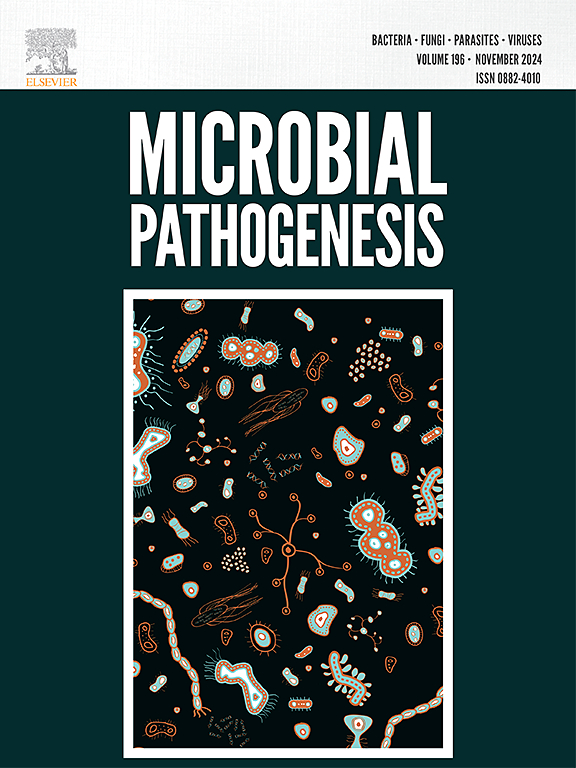Galleria mellonella larvae as a model for Helicobacter pylori biofilm formation under antibiotic stress
IF 3.3
3区 医学
Q3 IMMUNOLOGY
引用次数: 0
Abstract
Helicobacter pylori is a common Gram-negative bacterium that inhabits the human stomach and causes a variety of gastric pathologies. One of the growing concerns is its dynamic spread of antibiotic resistance, a process in which biofilm formation is involved. Therefore, it is necessary to find an appropriate, high-throughput research model for the in vivo biofilm development by H. pylori. The aim of the current research report was to determine the usefulness of G. mellonella larvae in assessing the survival of a multidrug-resistant, strong biofilm producing H. pylori strain during its exposure to stress caused by clarithromycin. Using infection models lasting for 3 or 6 days, we confirmed the ability of the tested H. pylori strain to survive in the larvae. We noticed that exposure to clarithromycin significantly reduced the number of cultured bacteria relative to the control, although we did not observe any differences in the number of bacteria using time-lapse, live analysis of fluorescently stained larval hemolymph samples. In conclusion, we confirmed that the examined H. pylori strain can produce biofilm in G. mellonella larvae organism and is able to survive exposure to minimal inhibitory concentrations of clarithromycin (established in vitro) in in vivo conditions. Further refinement of methodologies for monitoring the viability of clinical H. pylori strains in the greater wax moth larvae will enhance the accuracy and reliability of this promising research model.

幽门螺杆菌生物膜在抗生素胁迫下的形成模型--麦鸡幼虫
幽门螺杆菌是一种常见的革兰氏阴性细菌,栖息于人类胃部并导致多种胃部病变。人们日益关注的问题之一是其抗生素耐药性的动态传播,这一过程涉及生物膜的形成。因此,有必要为幽门螺杆菌体内生物膜的形成找到一个合适的高通量研究模型。本研究报告的目的是要确定,在评估具有多重耐药性、能形成强大生物膜的幽门螺杆菌菌株在克拉霉素造成的压力下的存活率时,是否可以使用麦角菌幼虫。利用持续 3 天或 6 天的感染模型,我们证实了受测幽门螺杆菌菌株在幼虫体内的存活能力。我们注意到,与对照组相比,接触克拉霉素会显著减少培养细菌的数量,尽管我们通过对荧光染色的幼虫血淋巴样本进行延时实时分析,并没有观察到细菌数量的任何差异。总之,我们证实所研究的幽门螺杆菌菌株能在 G. mellonella 幼虫体内产生生物膜,并能在体内暴露于最小抑菌浓度的克拉霉素(体外确定)下存活。进一步完善监测临床幽门螺杆菌菌株在大蜡蛾幼虫体内存活能力的方法将提高这一前景广阔的研究模型的准确性和可靠性。
本文章由计算机程序翻译,如有差异,请以英文原文为准。
求助全文
约1分钟内获得全文
求助全文
来源期刊

Microbial pathogenesis
医学-免疫学
CiteScore
7.40
自引率
2.60%
发文量
472
审稿时长
56 days
期刊介绍:
Microbial Pathogenesis publishes original contributions and reviews about the molecular and cellular mechanisms of infectious diseases. It covers microbiology, host-pathogen interaction and immunology related to infectious agents, including bacteria, fungi, viruses and protozoa. It also accepts papers in the field of clinical microbiology, with the exception of case reports.
Research Areas Include:
-Pathogenesis
-Virulence factors
-Host susceptibility or resistance
-Immune mechanisms
-Identification, cloning and sequencing of relevant genes
-Genetic studies
-Viruses, prokaryotic organisms and protozoa
-Microbiota
-Systems biology related to infectious diseases
-Targets for vaccine design (pre-clinical studies)
 求助内容:
求助内容: 应助结果提醒方式:
应助结果提醒方式:


